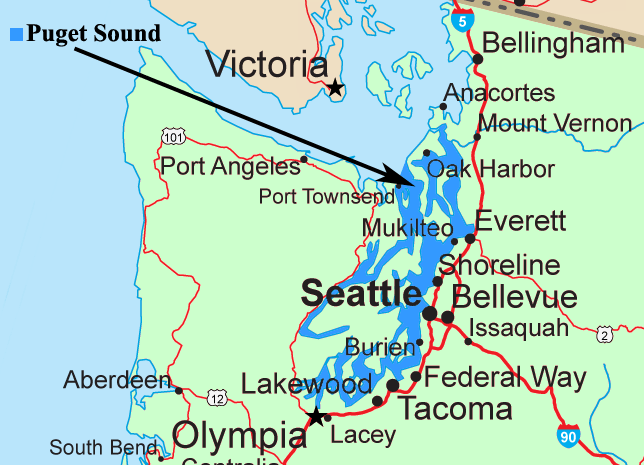
You can’t spend much time in Western Washington without encountering the term “Puget Sound”. It’s a strange phrase that, to the uninitiated, makes no obvious sense. Here is a primer to bring you up to speed:
What is a Puget?
Puget is a name. Specifically, it is the name of a member of Captain George Vancouver’s 1792 exploration crew, Lieutenant Peter Puget.
What is a Sound?
A sound is a body of water that is a major arm or inlet of a sea or ocean.
What is Puget Sound?
Here’s where it can be confusing. Puget Sound is the name of the body of water that lies between Washington’s Olympic Peninsula and the Seattle metropolitan region, extending down to Olympia. Locally, it is often referred to as The Puget Sound, or just “the sound.”
Puget Sound is also a name used for the region. This region includes all of the land surrounding the body of water called Puget Sound whose rivers empty into the sound. It includes the cities of Everett, Seattle, Tacoma, and Olympia, as well as many islands, the Kitsap Peninsula, and the eastern side of the Olympic Peninsula.
Puget Sound Geography
The Puget Sound is bordered by land on all sides except its north edge. According to the US Board on Geographic Names, the Puget Sound’s northern border is defined by the line between Point Wilson, near the Olympic Peninsula town of Port Townsend, and Point Partridge, located on the west side of Whidbey Island (see map above).
The Puget Sound is part of a larger body of water known as the Salish Sea, which also includes the Strait of Juan de Fuca, Bellingham Bay, and the Strait of Georgia.
The Strait of Juan de Fuca lies between Washington’s Olympic Peninsula and Vancouver Island. The Strait of Georgia is the body of water between mainland British Columbia and Vancouver Island. The Strait of Juan de Fuca is the primary connection between Puget Sound and the open Pacific Ocean.
To add to the confusion regarding which sections of water are part of Puget Sound, many of the bays, passages, and inlets also have their own unique names. All of these are part of Puget Sound: Admiralty Inlet, Hood Canal, Skagit Bay, and Saratoga Passage.
There are many islands in Puget Sound, including Whidbey Island, Bainbridge Island, and Vashon Island. The San Juan Islands are not in Puget Sound.
The Human History of Puget Sound
There have been human communities around the Puget Sound for thousands of years. The Native Peoples of the Puget Sound include the Lummi, Swinomish, Stillaguamish, Tulalip, Suquamish, Nisqually, and Skokomish. Captain George Vancouver and his crew aboard the Discovery explored Puget Sound in 1792. It was Vancouver who named the waters, honoring crew member Lieutenant Peter Puget.
Cities and towns grew around Puget Sound during the latter half of the 19th century. Today, over four million people call the region home.
The Natural History of Puget Sound
The Puget Sound was carved by glaciers, which left behind an island-filled, channeled body of water with over 2500 miles of shoreline. The average depth of Puget Sound is 440 feet, with some spots over 900 feet deep. It is both an inlet and a great estuary, with hundreds of rivers and streams emptying into the Sound, where fresh and salt water combine to create unique ecosystems.
The climate around the Puget Sound is wet and mild, with summer highs in the 70s and winter lows in the 30s. At any given time within the Puget Sound region, the weather conditions can vary widely. These variations are due to the rain shadow effect of the Olympic Mountains, human development, the complex topography, and atmospheric inversion layers.
Many fascinating creatures make their home in and around Puget Sound. These include:
- geoducks
- North Pacific giant octopus
- salmon
- cod
- rockfish
- sea urchins
- starfish
- crab
- orcas
- seals
- sea lions
- otters
- Minke whales
- gray whales
- humpback whales
- Harbor porpoises
- Dall’s porpoises
- tufted puffins
- sandpipers
- Great Blue herons
Learn More About The Puget Sound
If you are interested in learning more about Puget Sound, I recommend these resources:
The Natural History of Puget Sound Country by Arthur R. Kruckeberg
This book takes an in-depth look at many scientific aspects of the Puget Sound, including geology, climate, ecology, and human impact. It is suitable for the curious and for scholars.
Puget Sound Partnership
This state agency works in cooperation with numerous public and private organizations to protect and restore Puget Sound ecosystems. This is a great resource to learn about what you can do to protect Puget Sound.
Encyclopedia of Puget Sound
Produced by the University of Washington’s Puget Sound Institute, this online encyclopedia provides extensive and fascinating information about Puget Sound chemistry, biology, geography, and social and economic issues.
